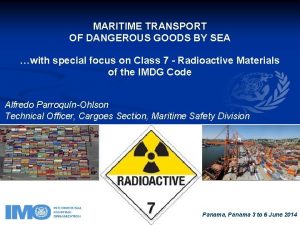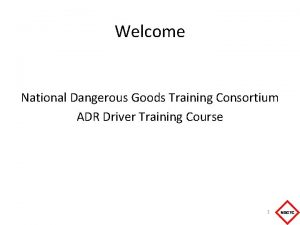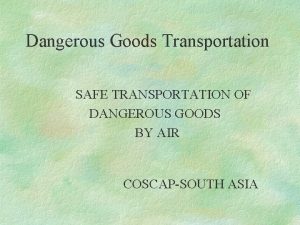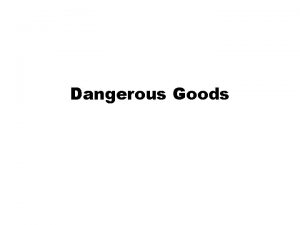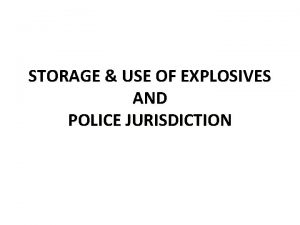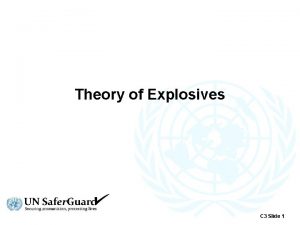DANGEROUS GOODS SIGNS CLASS 1 1 1 Explosives






- Slides: 6

DANGEROUS GOODS SIGNS

CLASS 1 1. 1 — Explosives with a mass explosion hazard. (nitroglycerin/dynamite) 1. 4 — Explosives with a major fire hazard. (consumer fireworks, ammunition) 1. 2 — Explosives with a blast/projection hazard. 1. 5 — Blasting agents. 1. 3 — Explosives with a minor blast hazard. (rocket propellant, display fireworks) 1. 6 — Extremely insensitive explosives.

CLASS 2 2. 1 Flammable Gas: Gases which ignite on contact with an ignition source, such as acetylene and hydrogen. 2. 2 Non-Flammable Gases: Gases which are neither flammable nor poisonous. Includes the cryogenic gases/liquids (temperatures of below -100°C) used for cryopreservation and rocket fuels, such as nitrogen and neon. 2. 3 Poisonous Gases: Gases liable to cause death or serious injury to human health if inhaled; examples are fluorine, chlorine, and hydrogen cyanide. 1. 3 — Explosives with a minor blast hazard. (rocket propellant, display fireworks)

CLASS 3 Flammable liquids included in Class 3 are included in one of the following packing groups: Packing Group I, if they have an initial boiling point of 35°C or less at an absolute pressure of 101. 3 k. Pa and any flash point, such as diethyl ether or carbon disulfide; Packing Group II, if they have an initial boiling point greater than 35°C at an absolute pressure of 101. 3 k. Pa and a flash point less than 23°C, such as gasoline (petrol) and acetone; or Packing Group III, if the criteria for inclusion in Packing Group I or II are not met, such as kerosene and diesel. Note: For further details, check the Dangerous Goods Transportation Regulations of the country of interest.

CLASS 4 / 5 4. 1 Flammable Solids: Solid substances that are easily ignited and readily combustible (nitrocellulose, magnesium, safety or strike-anywhere matches) 5. 1 Oxidizing agents other than organic peroxides (calcium hypochlorite, ammonium nitrate, hydrogen peroxide, potassium permanganate). 4. 2 Spontaneously Combustible: Solid substances that ignite spontaneously (aluminium alkyls, white phosphorus) 5. 2 Organic peroxides, either in liquid or solid form (benzoyl peroxides, cumene hydroperoxide). 4. 3 Dangerous when Wet: Solid substances that emit a flammable gas when wet or react violently with water (sodium, calcium, potassium, calcium carbide)

CLASS 6 / 7 / 8 / 9 6. 1 a Toxic substances which are liable to cause death or serious injury to human health if inhaled, swallowed or by skin absorption (potassium cyanide, mercuric chloride) 6. 2 Biohazardous substances; the World Health Organization (WHO) divides this class into two categories: Category A: Infectious; and Category B: Samples (virus cultures, pathology specimens, used intravenous needles) Class 8: Corrosive substances are substances that can dissolve organic tissue or severely corrode certain metals: 8. 1 Acids: sulfuric acid, hydrochloric acid 8. 2 Alkalis: potassium hydroxide, sodium hydroxide Class 9: Miscellaneous Hazardous substances that do not fall into the other categories (asbestos, air -bag inflators, self inflating life rafts, dry ice). Class 7: Radioactive substances comprise substances or a combination of substances which emit ionizing radiation (uranium, plutonium).


